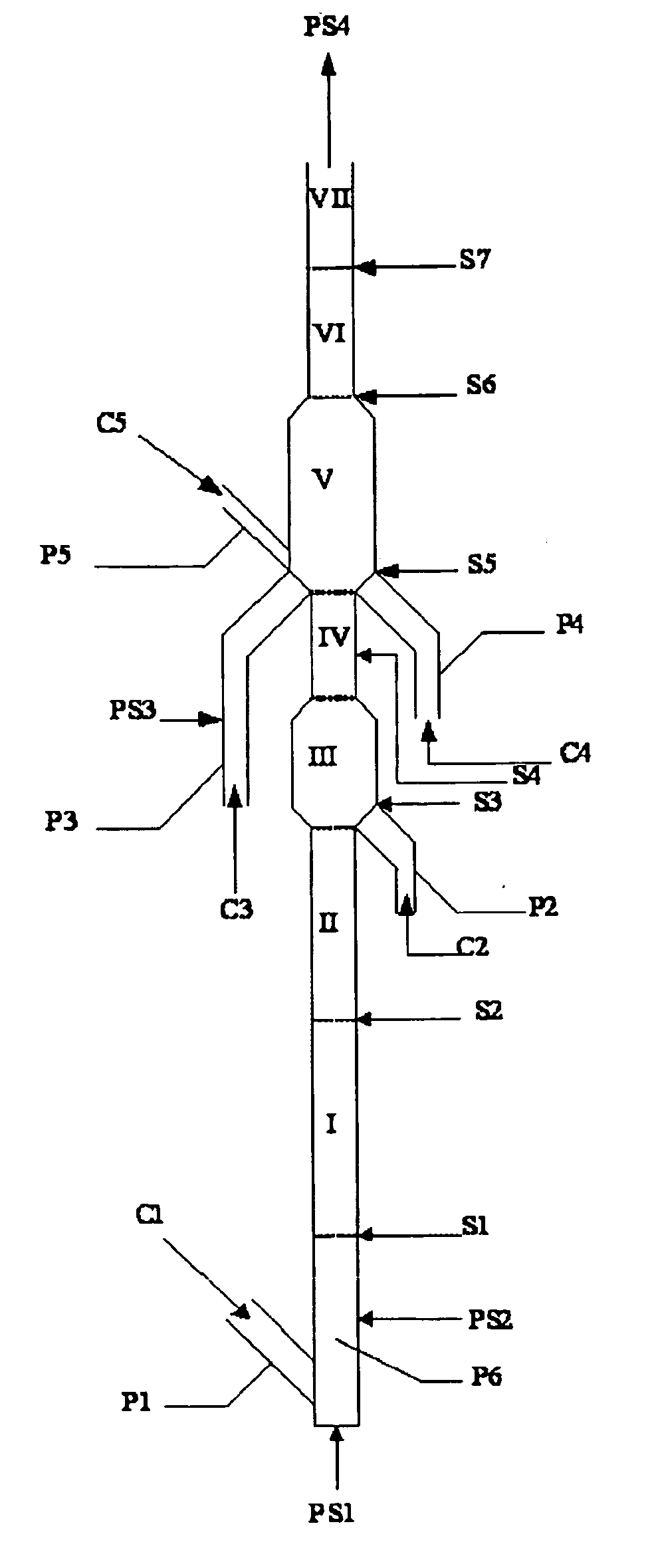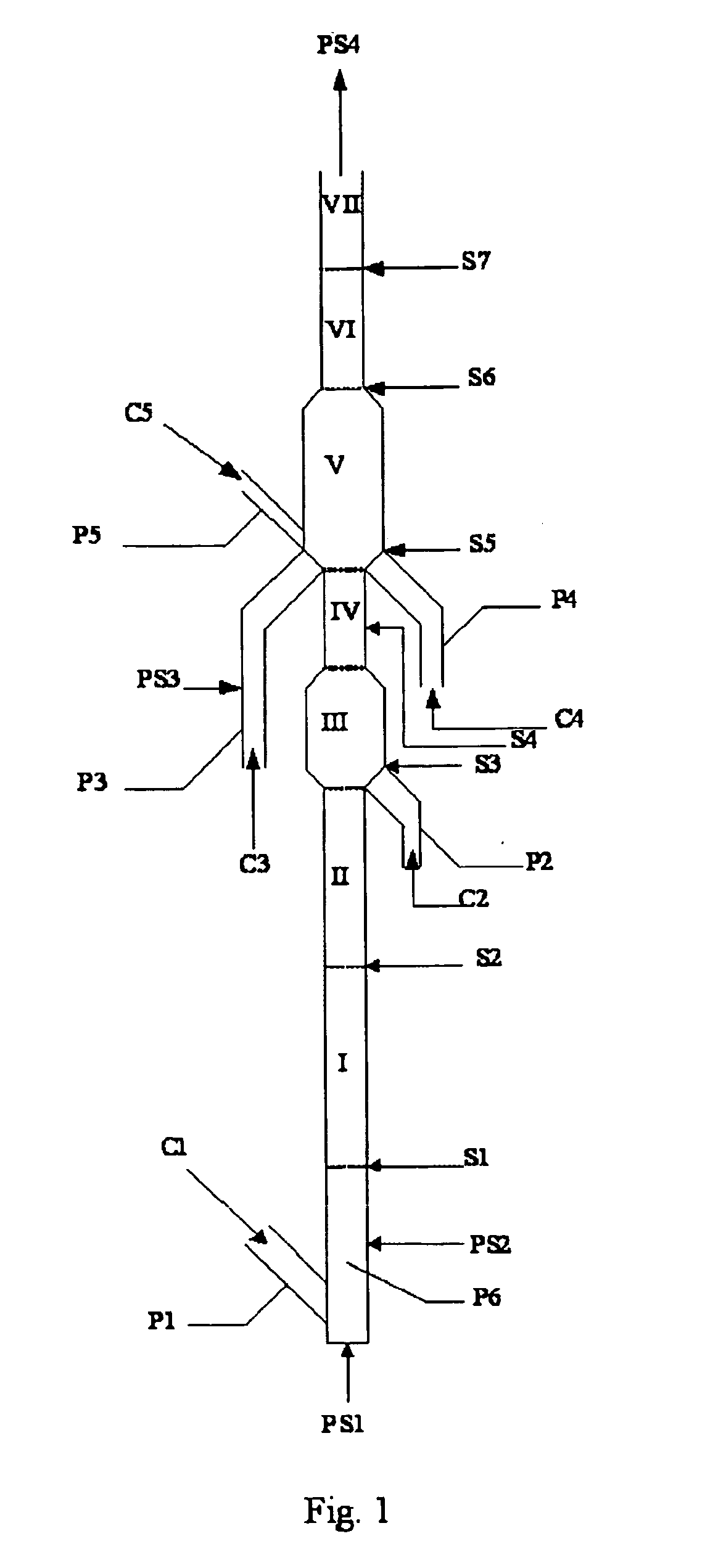Process for producing light olefins and aromatics
- Summary
- Abstract
- Description
- Claims
- Application Information
AI Technical Summary
Benefits of technology
Problems solved by technology
Method used
Image
Examples
embodiment 2
[0056]Another example process for producing light olefins and aromatics includes the following steps.
[0057](1) A feedstock, and optionally a recycle stream, enter the hydrotreating unit and react with a hydrotreating catalyst and hydrogen under the conditions of a hydrogen partial pressure between about 3.0 MPa and about 20.0 MPa, a reaction temperature between about 300° C. and about 450° C., a hydrogen / oil ratio between about 300 and 2000 by volume, and a LHSV between about 0.1 h−1 and 3.0 h−1. The reaction effluent is separated to obtain hydrotreated product and hydrogen is recycled for use.
[0058](2) The hydrotreated product comes into contact with a catalytic cracking catalyst and reacts under the conditions of a reaction temperature between about 400° C. and 800° C. and a WHSV between about 0.1 h−1-750 h−1 in at least two reaction zones, wherein the reaction temperature of at least one reaction zone out of the reaction zones downstream of the first reaction zone is higher than ...
embodiment 3
[0066]Another example process for producing light olefins and aromatics includes the following steps.
[0067](1) A feedstock reacts with hydrogen and a hydrotreating catalyst under the conditions of a hydrogen partial pressure between about 3.0 MPa and 20.0 MPa, a reaction temperature between about 300° C. and 450° C., a hydrogen / oil ratio between about 300-2000 by volume, and a LHSV between about 0.1 h−1-3.0 h−1. The reaction effluent is then separated to obtain H2, CH4, hydrotreated C20-C40, hydrotreated naphtha, and hydrotreated product, the hydrotreated product, hydrogen being recycled for use.
[0068](2) The hydrotreated product of step (1) reacts with a catalytic cracking catalyst under the conditions of a reaction temperature between about 400° C. and 800° C. and a WHSV between about 0.1 h−1-750 h−1 in at least two reaction zones. The reaction temperature of at least one reaction zone downstream of the first reaction zone is higher than that of the first reaction zone, and the WH...
example 1
[0111]The experiment of the present example was carried out according to the flow in FIG. 1. Feedstock A was directly used as the feedstock of catalytic cracking and the experiment was carried out in seven reaction zones consisting of risers and fluidized beds. The reaction temperatures of reaction zones I, II, III, IV, V, VI, and VII sequentially were 530° C., 520° C., 550° C., 540° C., 640° C., 620° C., and 580° C., and the WHSVs of reaction zones I, II, III, IV, V, VI, and VII sequentially were 360 h−1, 720 h−1, 20 h−1, 180 h−1, 5 h−1, 200 h−1, and 620 h−1, wherein the reaction temperatures of reaction zones III and V were 20° C. and 110° C. higher than that of reaction zone I respectively, the ratio of WHSVs of reaction zones III and V (fluidized bed) to that of reaction zone I (riser) were 1:18 and 1:72 respectively, and the heats supplemented to reaction zones III and V account for 11% and 60% of the reaction heat of the total reaction system respectively. Finally, the product...
PUM
 Login to View More
Login to View More Abstract
Description
Claims
Application Information
 Login to View More
Login to View More - R&D
- Intellectual Property
- Life Sciences
- Materials
- Tech Scout
- Unparalleled Data Quality
- Higher Quality Content
- 60% Fewer Hallucinations
Browse by: Latest US Patents, China's latest patents, Technical Efficacy Thesaurus, Application Domain, Technology Topic, Popular Technical Reports.
© 2025 PatSnap. All rights reserved.Legal|Privacy policy|Modern Slavery Act Transparency Statement|Sitemap|About US| Contact US: help@patsnap.com



